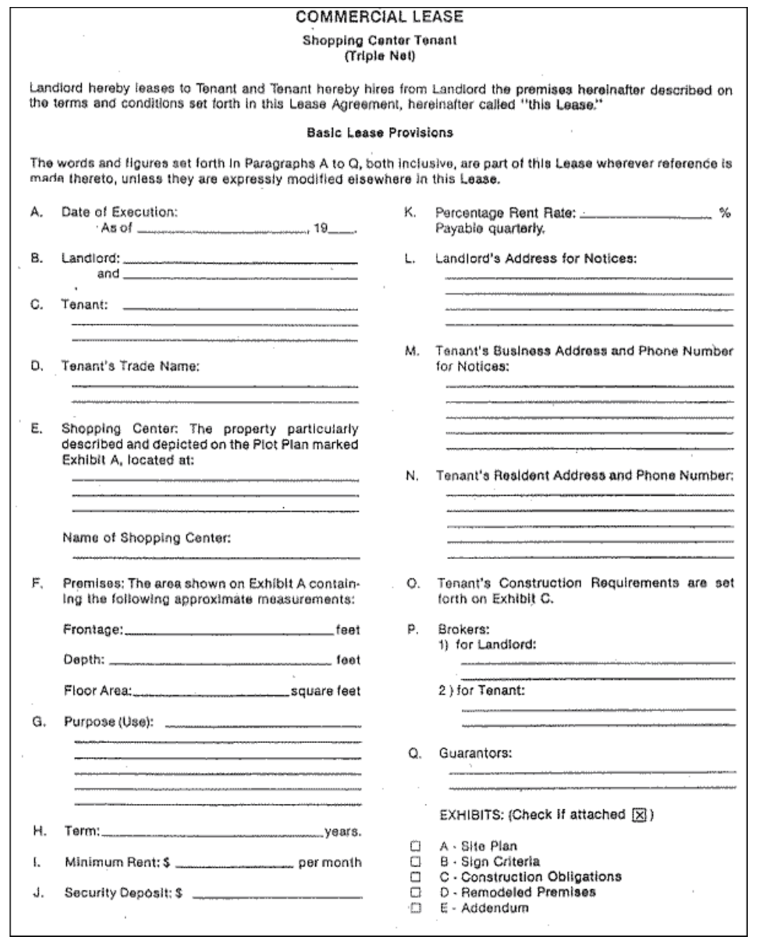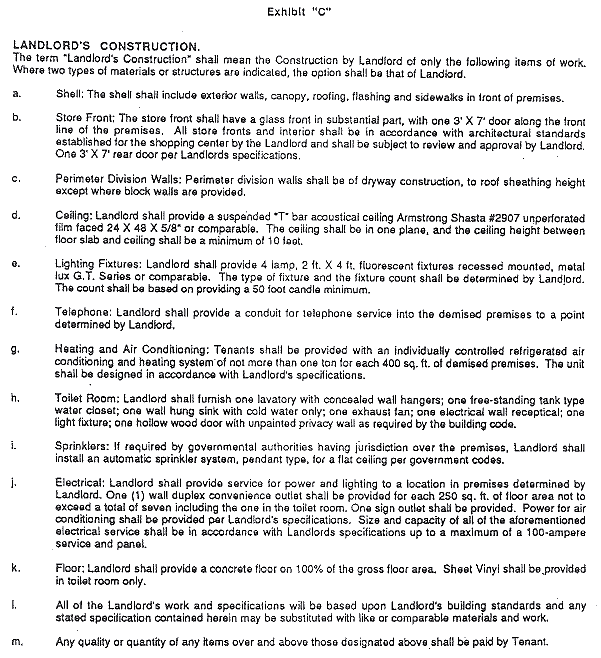Provided by My Own Business, Content Partner for the SME Toolkit
OBJECTIVE:
A poor location or a poorly negotiated lease can cripple a wonderful business. Every business has its own location criteria. In this session, you will define your criteria, learn how to select the right location, create a site model, and recognize the important aspects of a lease agreement.
- Location, Location, Location
- Zoning Categories
- Criteria for Home-Based Business
- Criteria for a Manufacturing, Warehousing or Industrial Business
- Criteria for a Retail Business
- Leasing Checklist
- Points to Consider Before Signing a Lease or Purchasing Property
- Basic Lease Provisions
- Lease Check-Off List
- To Rent or to Buy Considerations
- Do Your Homework
- Site Location Criteria
- Evaluation Table
- Top Ten Do’s and Don’ts
- Business Plan
Location, Location, Location
Whether you are a moonlight or full-time entrepreneur, at some time real estate issues will become important to you. The success or failure of most retail businesses will hinge on the owner’s selectivity and judgment in selecting the right location.
An initial step in business is selecting where you will live and where your business will be located. You may have the opportunity to relocate to an area where you would really enjoy living and working.
If you are planning to become a franchisor of your business, successful real estate development and precise location criteria for your franchised locations will become key factors in your success.
Zoning Categories
Every city has a planning department at City Hall. You will be dealing with this and other municipal departments and agencies that have discretionary authority to approve or disapprove your intended plans.
You can no longer rely on zoning codes to determine what the rules are in your desired location. Your intended location will often be subject to “precise plan” approval, an environmental impact assessment, and other regulatory issues.
You may find yourself appearing before a review board that can often seem unreasonable in its decisions. Many cities have redevelopment agencies authorized to impose conditions even more stringent than those established by local codes.
One shopping center developer was so frustrated with the demands of city agencies that he finally threw up his hands and sold off his rights to the property. The new owner succeeded in developing the property. His secret, “I went to City Hall and told them that I would do anything they wanted me to do—–and did it.”
Now, obviously, there will be times when unreasonable conditions will make a location for your business unattractive. In such cases, you should unemotionally look for another location.
Criteria for Home-Based Businesses
Be sure your home business is permitted and you have the license required by the city. Many homes have an association with regulations for the owners. Check to ensure you are in compliance. See our home-based business session for those considering operating a business from their home.
Criteria for a Manufacturing, Warehousing, or Industrial Business
- Room for future expansion
- Convenient for employees
- Good Accessibility
- Available labor force
- Appropriate utilities
- Convenient to freight and express delivery systems
Criteria for a Retail Business
Each retail and commercial business has its own criteria. For example, a donut shop should be located on the “going-to-work” side of the street. On the other hand, a liquor store should be on the side of the street with traffic going home from work.
The selection of your first location will have an overwhelming impact on your chances of success.
In the module Deciding on a Business, you analyzed businesses that are similar to the one you chose. Did you analyze where they were located and why?
- Select the appropriate type of center (mall, strip, mini). Some businesses do best in a large center but some, like Mini-Marts, video stores, and laundromats, do better in much smaller centers. Others such as florist, nursery or antique stores, do well located on the street front.
- Demographic data will provide you information about the neighborhood. It will inform you about the population, the number of households, estimated population by race, age, and income level within a one, two or five-mile radius. You can find firms that supply this information on the Internet.
- Walk and talk the area. You will be surprised how much you can learn by talking to customers, employees and owners.
- Traffic count is very important because it will give you the number of cars at the intersection. You can also get the pedestrian count, which is great for drop-in or walk-in business. This report can be obtained from the local traffic department.
- Visibility and signage: Customers must know you are there. They should be able to see your store. Usually, the end or corner location is better, which is why the rent for those spaces is higher. Get the biggest sign you can. Tell the public clearly what you are selling. Examples: Travel, Gifts, Pets, tell the products. Both your lease and the city ordinances will have limitations regarding your signs.
- Access and parking: Be sure you have adequate and convenient parking. Avoid streets with dividers or one-way traffic. Customers prefer stores where the parking is in the front.
- Proximity to the competition: Know where your competitors are located. You can get the names and address from an internet search. Find out what your competition is doing and how they are doing it.
- Generators (anchors): These are the big national stores in a mall or shopping center. For example, Albertson’s, Nordstrom, Walmart and/or McDonald’s will help to bring customers into the center. The closer your business can be to generators, the better it usually is for your business.
Searching for a Property
The internet is a good place to start looking for available properties. You want to partner with experienced agents that are familiar with the geography you’re interested in and who know the market.
Leasing Checklist
- Retain a real estate lawyer to assist you in negotiating your lease or purchase. A five-year lease on a $1,000 per month space is $60,000 (probably a personal obligation) and may well be your largest obligation for your beginning business.
- Most retail stores leases are Net, Net, Net (NNN) leases (a.k.a., Triple Net Lease) meaning that you as the tenant will pay for the taxes, insurance, gardening, utilities, security, trash and sewer, litter, graffiti removal and repairs. This charge is based on the square footage of your space. CAM (Common Area Maintenance) charges can be costly so find out the estimated cost per month before signing the lease. CAM charges can vary but will normally include parking lot sweeping and repair and all aspects of common area upkeep.
- Ask for options. At the end of your base term, you can then renew the lease or move. Try to keep your initial term short. There are some compelling reasons to have a short-term lease with options:
- Your business may not be successful at your initial location. A short-term lease will minimize your overall rent obligation.
- You need flexibility in lease terms to accommodate growth. Start-up businesses frequently find that their growth rate is more rapid than expected.
- Consider the possibility that you need to expand your business and will need more space. To provide for this, your lease could provide that if you need more room, your space can be expanded, you can move to another location in the center or you can cancel your lease.
- Don’t hurry your decision. There is no such thing as the last good location.
- Don’t judge entirely on rent. Pay fair rent for an outstanding location. Don’t let the leaser dictate all the lease terms.
You can assess your competition in your selected area by utilizing search engines (Google, Bing, Yahoo, etc.) Enter the type of business you plan to start and it will bring up a listing and map of all the existing businesses/competitors in your business category
Points to Consider Before Signing a Lease or Purchasing Property
- Is the location the best available in the area where you want to be?
- Does it meet your own specific criteria?
- Are utilities and tenant improvements adequate?
Basic Lease Provisions:

Rent: Is the rent comparable to other rents in the same location?
Term: Is your lease for a short-term (a year or less) or long-term?
Floor area: How much square footage of space? Rent and CAM charges are based on the square footage of your space.
Common area maintenance charges (CAM): What are the estimated charges for a year?
Options: Do you have options to renew the lease after the first term expires?
Rent increase: Is it a fixed rent increase or is it based on the CPI (Consumer Price Index). If CPI, negotiate a percentage cap.
Percentage rent: Some landlords will ask for fixed rent plus a percentage (of your sales) rent. This is an issue to negotiate.
Tenant improvements: Put the agreement in writing as to the responsibilities of the landlord and your responsibilities to do the necessary improvements to get the space open for business. Landlord’s Construction Exhibit “C” should be made a part of the lease. Please refer to the sample exhibit furnished in this session.
Right to assign or sublet: Landlord’s consent “not to be unreasonably withheld.”
Signs: Be specific with exhibit and description.
Provision for expansion requirements: If you think your business will be expanding, make provisions in your lease to provide for anticipated future needs.
Parking rights: Be sure that adequate parking space is provided. In most retail centers, tenants share “common area parking” rights. Nearby restaurants or theaters can monopolize the parking spaces you require.
Personal guarantee: You should avoid this, if possible. If it is required, ask your lawyer to review this clause carefully.
Exclusive: Ask that no other business similar to yours be allowed in the center if it’s appropriate.
All Leases Have Exhibits

- Site plan, which is a drawing of the inside of the store, restrooms, windows, doors, A/C vents, and utilities.
- Sign criteria, put in a drawing of the type of sign you want, be sure to state color and size.
- Construction obligations: state exactly what the landlord will do and what you will do.
- Special requirements of tenant.
To Rent or to Buy Considerations
- For start-ups, the primary consideration is that capital is needed for the business.
- Are requirements going to change? If so, renting is probably preferable.
- Are there tax or borrowing incentives available if you buy?
- Some make more of the real estate than on the business. Talk to the Community Development Department.
- Ownership fixes future cost and availability of the location.
Do Your Homework
- Completely fill out a standard lease form with contingencies necessary for your particular business.
- Attend local Chamber of Commerce meetings to find out about community opportunities and concerns.
- Fully evaluate a specific location, including the completion of a “Site Criteria” table.
- Maintain contact with the community development department.
- Find and get to know a good real estate lawyer.
- Negotiate an actual lease as a dry-run practice.
Site Location Criteria
You can create your own “Site Model” to objectively evaluate locations for your business. Do this by assigning different values to the factors that are most important for your particular business. Then, each location can be evaluated against these measurements.
Real estate dealmakers concerned with buying, selling or leasing all require possession of expert negotiating skills. Since it has been determined that negotiating is a learned skill and not a natural one, our session “Develop Negotiating Skills” in Business Expansion is recommended.
Some things to keep in mind in site selection:
- There’s no such thing as the “last good location.”
- Copycatting your most successful competitor’s site criteria can help you avoid making mistakes.
- If you are building a chain of stores, never sign a lease on your second location until your first location is profitable and proven.
- It is better to pay a fair rent for a great location than pay great rent for a fair location.
- Don’t rely on leasing agents to make your site decisions.
- Driving streets and walking neighborhoods is a good way to scout for locations.
The following form gives you a methodical approach to evaluate the strengths and weaknesses of each potential location.
First, evaluate your site location for each factor on a scale of 1 to 10 (number 10 being the highest).
Second, decide the importance of each factor to your particular business on a scale of 1 to 5 (number 5 being the most important).
Multiply the grade by the weight to determine the points for each factor. Add up the points to get a total score. Repeat this process for each site to gain an objective, comparative analysis.
| Site Criteria Table | |||
| Factors | Grade 1-10 | Weight 1-5 | Points |
| Traffic count: Cars or pedestrians | |||
| Visibility access | |||
| Proximity to competition | |||
| Zoning | |||
| Parking (include off-street parking) | |||
| Condition of premises | |||
| Proximity to customer generators | |||
| Income level of neighborhood | |||
| Population density | |||
| Population age/age range | |||
| Directional growth of area | |||
| Area improving or deteriorating | |||
| Crime/shoplifting rates | |||
| Availability of qualified employees | |||
| Labor rates of pay | |||
| Supplier proximity | |||
| Terms and rental rates | |||
| Adequacy of utilities, gas, & water | |||
| Transportation accessibility | |||
| Total Points | |||
Top Ten Do’s and Don’ts
THE TOP TEN DO’S
- Talk to your city hall planning and zoning department to be sure your intended location conforms to all code requirements.
- Create a Site Model Criteria for your particular business.
- Look at many locations to establish comparable values for rent and location potential.
- Order demographic data to provide information about your customers.
- Retain a real estate lawyer to assist in negotiating your lease or purchase.
- To minimize your risk, negotiate for a short-term lease with options.
- Provide terms in your lease for potential expansion requirements.
- Have every agreement put into writing.
- Ask that no other similar business be allowed in your shopping center.
- Use signs that are the largest allowed and clearly state what you are selling.
THE TOP TEN DON’TS
- Be hasty in making a real estate decision. (There is no such thing as the last good location.)
- Don’t judge a location entirely on rent.
- Permit a potential landlord to dictate all the lease terms.
- Personally guarantee your lease if possible.
- Sign a purchase or lease document without the approval of your lawyer.
- Depend on the advice of a landlord’s leasing agent.
- Submit to unreasonable conditions; unemotionally look for another location.
- Depend on any verbal agreements with landlords or sellers – get it in writing.
- Open the second store until the first one is proven and profitable.
- Sign a lease without the condition that it is subject to securing all permits and licenses.
Business Plan for Session Location and Leasing
You can now continue to assemble your business plan. We provided Microsoft Word template for this section below:
The full template can be downloaded as one document:
Copyright © 1993, 1997-2016, My Own Business, Inc. All Rights Reserved.









